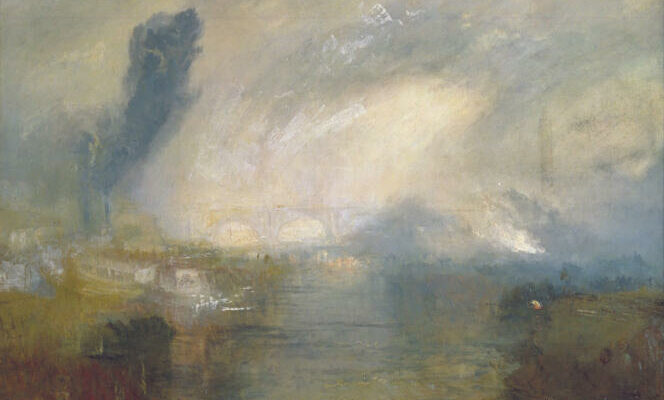The British capital sometimes looks like a painting by William Turner (1775-1851) with its heavy skies, its sea breeze and its changing lights. Lovers of the painter will head to the Tate Britain, a beautiful neoclassical building which houses an exceptional collection of his paintings. The visitor is greeted by the self-portrait of the young Turner, with his determined look, like on the 20 pound notes. He is then attracted by these fishermen at sea, at night, under the moon, vulnerable on the choppy waves near sharp reefs. Further on, the armies of Carthage are in difficulty, while Hannibal crosses the Alps. The mountains seem animated by the same jolts as the oceans. Painter of the flood in 1805, Turner depicts a black man who comes to the aid of a white woman in difficulty, “perhaps a sign of his anti-slavery beliefs », underlines Amy Concannon, curator at the Tate. The latter compares A frozen morningpainted in 1813, to a realistic painting “by Jean-François Millet”yet from the next generation, with its travelers stopped while the path is cleared to allow them to continue their journey.
Turner painted it ” Open eyes “, declared Monet with admiration. Elsewhere, Turner reports the Battle of Trafalgar in an extraordinary large format cluttered with ships, where we see Admiral Nelson wounded, very small, under the grapeshot of the French – ultimately defeated. Attentive to the developments of his time, he is interested in whaling fishermen, the arrival of the train or the steamboats which replace sailboats, as evidenced by The Last Voyage of the Bold (1838), kept in the National Gallery.
But Turner’s most famous paintings are perhaps those where the figure is lost. Exhibited at the MoMA in New York in 1966, they revived interest in his work. In a room at the Tate, they burst into full light. The eye is bathed in these diffracted golds, these stars of pure beauty. “It has been said a lot that these paintings are modern, that they announce impressionism. But they are actually unfinished”, recalls the curator. One of the most famous, Norham Castle, sunrise (circa 1845), diffuses an ethereal, radiant and soothing glow. A stylized orange cow drinks water from a river in front of the blue mountain and the immense yellow sun. These vibrations can be compared to the works of Rothko, currently displayed in majesty at the Louis Vuitton Foundation in Paris. At the Tate, alongside the Turners, a yellow Rothko from 1950 is on display. A century later, the association works.
You have 55% of this article left to read. The rest is reserved for subscribers.
